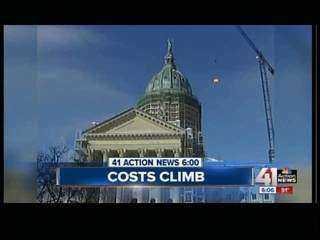The next time Kansas spends more than a decade and almost a third of a billion dollars to fix up the state Capitol, it will get receipts.
So say the state’s top elected purse keepers, the State Finance Council, a nine-member panel that makes the state’s big financial decisions when the Legislature is not in session.
The council has voted 7-1 to approve what it hopes will be the final financing package for a now $337 million restoration of the Kansas State Capitol, returning it to its grandeur of 1903, when workers finished the original building.
Triple Estimated Cost
The cost is about three times more than legislators had estimated. The restoration work began in 2001.
Kansas Gov. Sam Brownback (R) and the top four Republican and Democratic members of the Kansas House and the Kansas Senate comprise the council.
Statehouse Architect Barry Greis and state Secretary of Administration Dennis Taylor wanted the council to approve a $17.4 million financing package for driveways, landscaping and a visitors center — on the Capitol’s north side — designed as a public front door. Features would include a lobby, elevators, security areas, audio and visual rooms, and a dining area, Greis said.
The center, a construction entrance during most of the decade-long project, remains a bare concrete shell, inaccessible to the public and partitioned by drywall, plywood and other elements common to temporary construction.
“And that’s the way it will look if we don’t approve (the $17.4 million financing) today,” Greis told the panel.
‘A Serious Misunderstanding’
Two panel members, House Speaker Mike O’Neal (R-Hutchinson) and House Appropriations Committee Chairman Marc Rhoades (R-Newton), believed costs for the visitors center were included in the $320 million in state borrowing okayed by lawmakers to finance the work.
“It was my understanding that we were done with the bonding that was necessary to get us access and functionality at the Capitol,” O’Neal said. “This is a serious misunderstanding.”
Even so, Greis insisted, a more than 1,780-page master contract between Kansas and JE Dunn Construction of Kansas City, the project’s chief contractor, clearly shows legislators had not approved the money to finish the center.
Few legislators have actually seen that contract. Only one copy is known to exist, tucked in a vault at the Kansas Department of Administration.
Greis and other department workers cite specific clauses and document those when legislators ask, but the sheer length and complexity of the Capitol restoration probably overwhelmed that process, O’Neal said in an interview.
‘Details Get Lost’
“I think I’m the third Speaker who has been involved in this (oversight of the restoration work),” O’Neal said. “Details get lost in a situation like that.”
Commission members resolved their immediate problems by requiring Greis and administration department officials to provide a detailed summary of work covered by the requested money.
“We understand cost overruns,” said Rhoades, the appropriations committee chairman. Earlier legislatures added to the original plans an underground parking garage and ground floor office space. Restoration workers found unexpected problems behind old walls.
“But this confusion about what was covered before is concerning,” Rhoades said. “I believe the House would like to see more accountability.”
The package approved in the 7-1 vote is complex.
The state will borrow about $5.4 million by selling bonds to pay part of the cost. Contractors on the project will chip in $5 million more, money saved on other projects at the Capitol over the past decade, said architect Greis, the state’s point man on the project.
Some $7 million more will come from Kansas’ go-to source for extra cash – the state highway fund.
Raids on Highway Funds
Since 2000, Kansas governors and legislators from both parties have tapped state highway funds for a total $1.5 billion to help ease other budgetary problems, the Kansas Department of Transportation calculates. The department’s budget is about $1.6 billion annually.
Brownback’s predecessor, former Gov. Mark Parkinson, a Democrat, used $189 million in KDOT money to stretch Kansas’ fiscal 2010 budget, and $195 million in 2011 to replace tax revenue lost in the Great Recession. Brownback transferred $205 million of KDOT money into the budget to pay Medicaid costs and sent $33 million to the Kansas Highway Patrol.
No road construction money will go toward the renovation, Brownback and KDOT officials insist. Instead, the money will come out of operations funds used to buy trucks, computers, fuel, office supplies and anything else not directly related to construction or other core transportation commitments, said Steve Swartz, a KDOT spokesman.
Kansas Senate Ways and Means Chairwoman Carolyn McGinn (R-Sedgwick) was the lone council member to vote against the financing package.
‘Using As Slush Fund’
McGinn said she voted against the proposal, in part, because she thinks legislators are too quick to use highway money.
“It seems like we’re continuing to use this as a slush fund,” McGinn said.
McGinn said the full Legislature, and not just the committee, should look at the issue.
“I truly believe this is the people’s building,” McGinn said. “I believe that the people who represent the people should be the ones that vote for that.”
Gene Meyer ([email protected]) is editor of KansasWatchdog.org. Used with permission.




